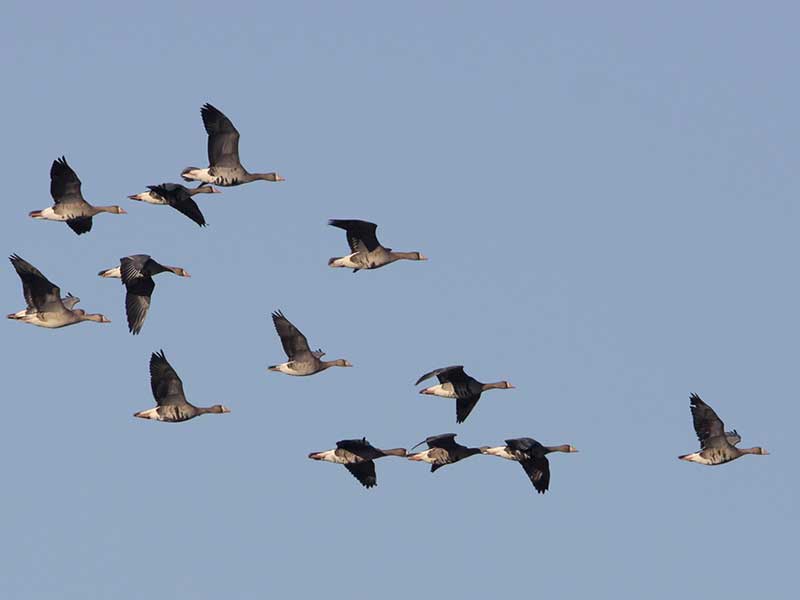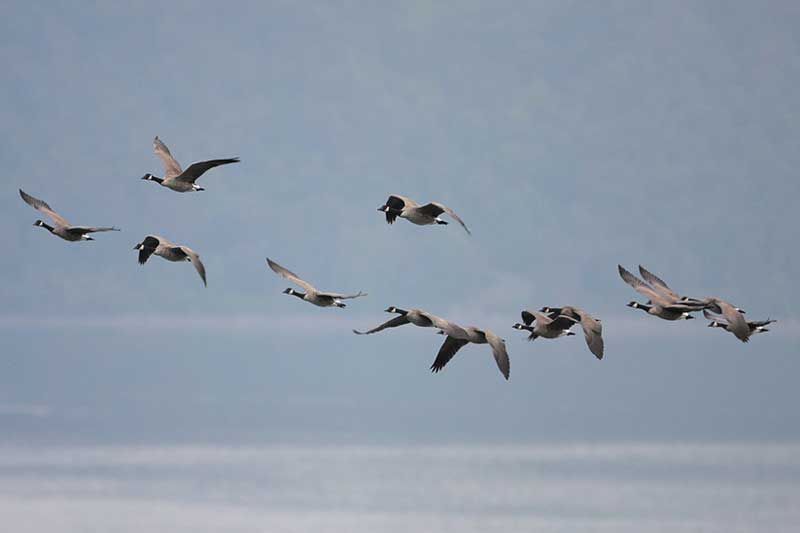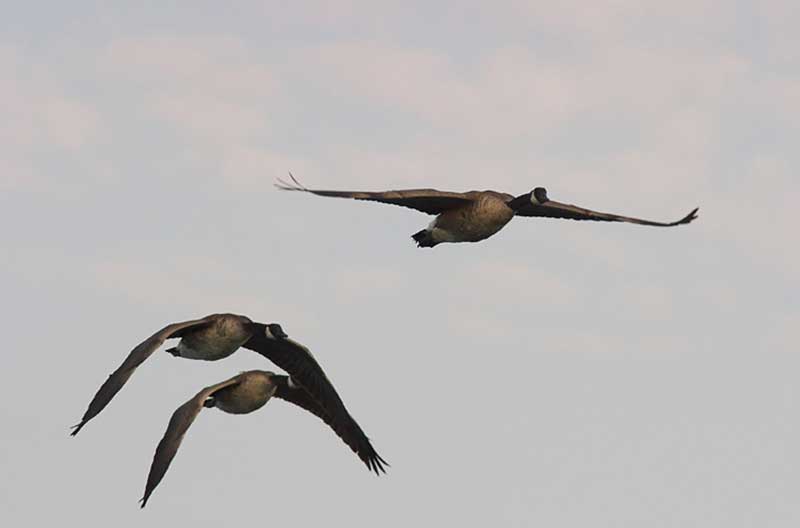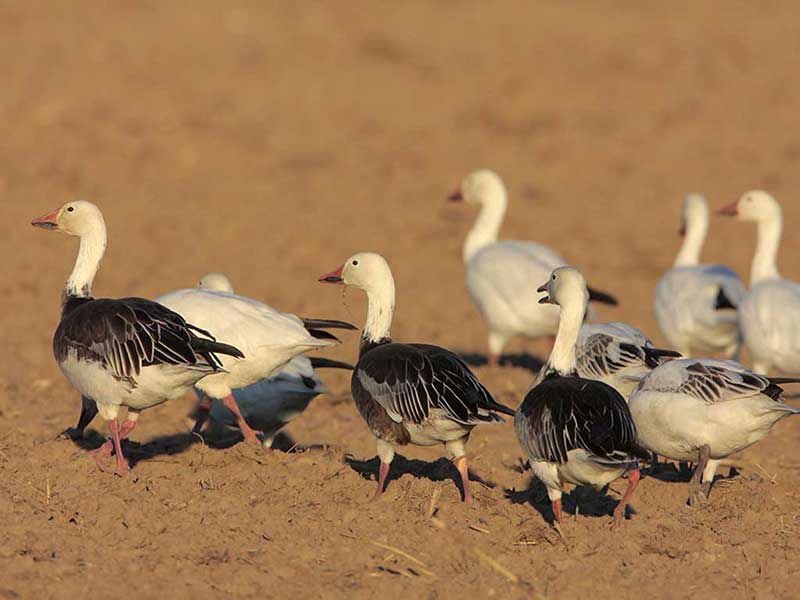
A group of geese is called a gaggle. We know geese as very vocal birds rarely seen on their own, so it’s only natural to wonder if they have collective names.
Although a group of Geese is technically a flock of birds, they are mostly called a gaggle. But this is not where the fun ends – there are many other names for them!
On this page
What is a Group of Geese Called?
A group of geese is called a gaggle. This odd expression came into being hundreds of years ago in England, a country that has always been visited by large flocks of wintering geese. You can read more here.
Several species of geese migrate through or spend the winter in coastal wetlands in England including Greater White-fronted Goose, Pink-footed Goose, Barnacle Goose, Graylag Goose, and other species. One of the things all of these big, duck-like birds have in common is a tendency to vocalize and make noise, sometimes, lots of loud noise.
Geese are very communicative, perhaps even more so when flocking.
If a goose is alone, the bird will make loud honking noises to locate other geese to join them.
When geese are in a gaggle, the noises they make tend to be quieter. However, they can also be constant and consist of small clucking and chattering sounds as they communicate with each other.
Related: How to get rid of geese (in your garden)
If a bird gives the alarm, or the birds feel that the time has come to migrate to another spot, that chattering can turn into loud honking that reaches a crescendo as they take flight.
Although no one knows exactly why the term gaggle started being used to describe a group of geese, it may be related to the sounds made by geese, related to the same word being used to describe a group of rowdy and disorderly people, or a bit of both explanations.
Some have also said that “gaggle” might be used for a group of geese because the same word has been used to describe groups of women loudly speaking with each other.
Why is a Group of Geese Called A Gaggle?
The origin of the word “gaggle” comes from an old Dutch word, “gagelen” and the subsequent Middle English word, “gagel”. These words mean, “to cackle”, a fair description of various geese vocalizations. The word itself might have also come into being as an imitation of the sounds that Geese make.
Although “gaggle” is the most common word to describe a flock of geese, technically, it only refers to a flock of geese on the ground. This is probably because geese are more communicative and cackle when resting and foraging together in a field or wetland than in flight.

Flock or a skein of Canada Geese
Another word, “skein” refers to a flock of geese in flight, and several other terms also exist to refer to a group of geese, including these ones:
- A chevron of geese – a “chevron” is a symbol shaped like a “V” and refers to the form a flock of geese often take during flight.
- A wedge of geese – likewise, the wedge hints at the tight formation geese travel in during migration.
- A plump of geese
- A bunch of geese
- A trip of geese
- A Christmas of geese – a cooked goose is a traditional aspect of an English Christmas dinner.
- A flight of geese
- A cluster of geese
- A herd of geese
- A string of geese – this may refer more to Brant, a small goose that flies in long lines or a “string”.
- A skein of geese – the term ‘skein’ comes from a piece of wool or a measure of yarn.
- A “V” formation of geese – this refers to the form a flock of Geese can take during flight.
- A plumb of geese
- A nide of geese
- A lag of geese
Do Geese Gather Together in the Wild?
Geese commonly gather together in the wild just as much as domestic birds. All species of geese, and many ducks, prefer to form flocks rather than forage on their own.
Related: What is a group of ducks called?
For the mating season, geese form pairs but as soon as the breeding season is over, they locate other geese so they can form flocks and continue to stick together during fall, winter, and early spring.
All species of geese form gaggles and skeins, and several species form flocks in the hundreds or even the thousands. In common with several other waterfowl (such as swans or ducks) and non-waterfowl bird species, geese group together for protection from predators.
With dozens, hundreds, or thousands of similar-looking birds to look through, predators can have trouble focusing on just one.

Canada Geese in flight
Geese are also much more likely to spot a predator at a safe distance and give the alarm than a goose on its own when in a gaggle. When geese forage, they are vulnerable since they can’t look out for danger.
Related: How long do geese live?
Foraging in a flock solves this dangerous dilemma because it ensures that at least some geese will always be watching for eagles and other predators while other geese forage.
During flight, flocking behavior also helps geese because flying in a “V” formation reduces drag and saves energy. The geese occasionally change positions to keep the first bird in the formation from becoming exhausted.
Frequently Asked Questions
What is a flock of Geese in flight called?
A flock of geese that are flying is called a skein. Geese fly in skeins but are known as a “gaggle” when they are on the ground.
Is it a gaggle or a flock of Geese?
The correct term for a flock of geese is a “gaggle.”
Is a group of Geese called a gander?
No, the correct term for a group of geese is a “gaggle”. A gander is a male goose. The female goose is still called goose.
What is a group of baby geese called?
Baby geese are called goslings, so a group of nestlings or fledglings can be called goslings or a brood of goslings.
Are there terms for different groups of goose species?
In most cases, there are no specific terms for different species, so a group of Barnacle Geese is called either a gaggle or a flock. However, there are some interesting terms for a group of Snow Geese, such as a blizzard or an avalanche. A group of Canada Geese is often referred to as a wedge of Canada Geese, whereas a group of Bean Geese is called a pod!
What is a pair of geese called?
There is no specific term for a pair of geese. They are often just called geese or a pair of geese.
Conclusion
A group of geese is known as a “gaggle,” a term that comes from Dutch and Middle English words that mean, “to cackle” or “gather in a rowdy and disorderly manner”.
There are also additional terms for a group of geese, one of the more common types of birds typically seen in flocks in local parks, wetlands, and on golf courses.
Geese flock together for protection, whether domestic or in the wild, probably because these social birds like to be together. At least, that’s how it looks when a gaggle of geese makes frequent cackles to communicate with each other.
Do Groups of Birds Really Have Their Collective Nouns (And Meanings)?


